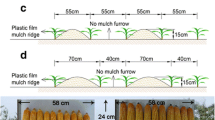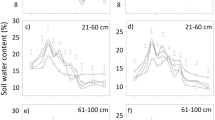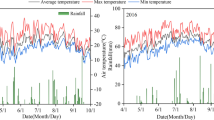Abstract
Ridge-furrow film mulching has been proven to be an effective water-saving and yield-improving planting pattern in arid and semi-arid regions. Drought is the main factor limiting the local agricultural production in the Loess Plateau of China. In this study, we tried to select a suitable ridge-furrow mulching system to improve this situation. A two-year field experiment of summer maize (Zea mays L.) during the growing seasons of 2017 and 2018 was conducted to systematically analyze the effects of flat planting with no film mulching (CK), ridge-furrow with ridges mulching and furrows bare (RFM), and double ridges and furrows full mulching (DRFFM) on soil temperature, soil water storage (SWS), root growth, aboveground dry matter, water use efficiency (WUE), and grain yield. Both RFM and DRFFM significantly increased soil temperature in ridges, while soil temperature in furrows for RFM and DRFFM was similar to that for CK. The largest SWS was observed in DRFFM, followed by RFM and CK, with significant differences among them. SWS was lower in ridges than in furrows for RFM. DRFFM treatment kept soil water in ridges, resulting in higher SWS in ridges than in furrows after a period of no water input. Across the two growing seasons, compared with CK, RFM increased root mass by 10.2% and 19.3% at the jointing and filling stages, respectively, and DRFFM increased root mass by 7.9% at the jointing stage but decreased root mass by 6.0% at the filling stage. Over the two growing seasons, root length at the jointing and filling stages was respectively increased by 75.4% and 58.7% in DRFFM, and 20.6% and 30.2% in RFM. Relative to the jointing stage, the increased proportions of root mass and length at the filling stage were respectively 42.8% and 94.9% in DRFFM, 63.2% and 115.1% in CK, and 76.7% and 132.1% in RFM, over the two growing seasons, showing that DRFFM slowed down root growth while RFM promoted root growth at the later growth stages. DRFFM treatment increased root mass and root length in ridges and decreased them in 0–30 cm soil layer, while RFM increased them in 0–30 cm soil layer. Compared with CK, DRFFM decreased aboveground dry matter while RFM increased it. Evapotranspiration was reduced by 9.8% and 7.1% in DRFFM and RFM, respectively, across the two growing seasons. Grain yield was decreased by 14.3% in DRFFM and increased by 13.6% in RFM compared with CK over the two growing seasons. WUE in CK was non-significantly 6.8% higher than that in DRFFM and significantly 22.5% lower than that in RFM across the two growing seasons. Thus, RFM planting pattern is recommended as a viable water-saving option for summer maize in the Loess Plateau of China.
Similar content being viewed by others
References
Böhm W. 2012. Methods of Studying Root Systems. Cham: Springer Nature, 188.
Bu L D, Zhu L, Liu J L, et al. 2013. Source-sink capacity responsible for higher maize yield with removal of plastic film. Crop Economics, Production & Management, 105(3): 591–598.
Chen X L, Wu P T, Ren X N, et al. 2012. Rainfall harvesting and mulches combination for corn production in the subhumid areas prone to drought of China. Journal of Agronomy and Crop Science, 198(4): 304–313.
Chen Y L, Liu T, Tian X H, et al. 2015. Effects of plastic film combined with straw mulch on grain yield and water use efficiency of winter wheat in Loess Plateau. Field Crops Research, 172: 53–58.
Eldoma I M, Li M, Zhang F, et al. 2016. Alternate or equal ridge-furrow pattern: which is better for maize production in the rain-fed semi-arid Loess Plateau of China? Field Crops Research, 191: 131–138.
Fan J L, McConkey B, Wang H, et al. 2016. Root distribution by depth for temperate agricultural crops. Field Crops Research, 189: 68–74.
Feng J, Zhao L D, Zhang Y B, et al. 2020. Can climate change influence agricultural GTFP in arid and semi-arid regions of Northwest China? Journal of Arid Land, 12(5): 837–853.
Feng W, Lu H W, Yao T C, et al. 2020. Drought characteristics and its elevation dependence in the Qinghai-Tibet Plateau during the last half-century. Scientific Reports, 10: 14323, doi: https://doi.org/10.1038/s41598-020-71295-1.
Gao H H, Yan C R, Liu Q, et al. 2019. Effects of plastic mulching and plastic residue on agricultural production: a meta-analysis. Science of the Total Environment, 651: 484–492.
Gao Y H, Xie Y P, Jiang H Y, et al. 2014. Soil water status and root distribution across the rooting zone in maize with plastic film mulching. Field Crops Research, 156: 40–47.
Gu X B, Li Y N, Du Y D. 2016. Continuous ridges with film mulching improve soil water content, root growth, seed yield and water use efficiency of winter oilseed rape. Industrial Crops and Products, 85: 139–148.
Gu X B, Li Y N, Du Y D. 2018. Film-mulched continuous ridge-furrow planting improves soil temperature, nutrient content and enzymatic activity in a winter oilseed rape field, Northwest China. Journal of Arid Land, 10(3): 362–374.
Gu X B, Cai H J, Zhang Z T, et al. 2019. Ridge-furrow full film mulching: an adaptive management strategy to reduce irrigation of dryland winter rapeseed (Brassica napus L.) in northwest China. Agricultural and Forest Meteorology, 266–267: 112–128.
Gu X B, Cai H J, Fang H, et al. 2020. Effects of degradable film mulching on crop yield and water use efficiency in China: a meta-analysis. Soil & Tillage Research, 202: 104676, doi: https://doi.org/10.1016/j.still.2020.104676.
Han J, Jia Z K, Wu W, et al. 2014. Modeling impacts of film mulching on rainfed crop yield in Northern China with DNDC. Field Crops Research, 155: 202–212.
He H J, Wang Z H, Guo L, et al. 2018. Distribution characteristics of residual film over a cotton field under long-term film mulching and drip irrigation in an oasis agroecosystem. Soil and Tillage Research, 180: 194–203.
He Q J, Zhou G S, Lü X M, et al. 2019. Climatic suitability and spatial distribution for summer maize cultivation in China at 1.5 and 2.0°C global warming. Science Bulletin, 64(10): 690–697.
Li R, Hou X Q, Jia Z K, et al. 2013. Effects on soil temperature, moisture, and maize yield of cultivation with ridge and furrow mulching in the rainfed area of the Loess Plateau, China. Agricultural Water Management, 116: 101–109.
Liu C A, Zhou L M, Jia J J, et al. 2014. Maize yield and water balance is affected by nitrogen application in a film-mulching ridge-furrow system in a semiarid region of China. European Journal of Agronomy, 52: 103–111.
Lobell D B, Hammer G L, McLean G, et al. 2013. The critical role of extreme heat for maize production in the United States. Nature Climate Change, 3: 497–510.
Mo F, Wang J Y, Xiong Y C, et al. 2016. Ridge-furrow mulching system in semiarid Kenya: a promising solution to improve soil water availability and maize productivity. European Journal of Agronomy, 80: 124–136.
Morales D, Rodríguez P, Dell’Amico J, et al. 2003. High-temperature preconditioning and thermal shock imposition affects water relations, gas exchange and root hydraulic conductivity in tomato. Biologia Plantarum, 46: 203–208.
Qi D L, Hu T T, Wu X, et al. 2015. Rational irrigation and nitrogen supply methods improving root growth and yield of maize. Transactions of the Chinese Society of Agricultural Engineering, 31(11): 144–149. (in Chinese)
Qin X L, Li Y Z, Han Y L, et al. 2018. Ridge-furrow mulching with black plastic film improves maize yield more than white plastic film in dry areas with adequate accumulated temperature. Agricultural and Forest Meteorology, 262: 206–214.
Ren X L, Zhang P, Chen X L, et al. 2016. Effect of different mulches under rainfall concentration system on corn production in the semi-arid areas of the Loess Plateau. Scientific Reports, 6: 19019, doi: https://doi.org/10.1038/srep19019.
Schenk H J, Jackson R B. 2002. Rooting depths, lateral root spreads and below-ground/above-ground allometries of plants in water-limited ecosystems. Journal of Ecology, 90: 480–494.
Thidar M, Gong D Z, Mei X R, et al. 2020. Mulching improved soil water, root distribution and yield of maize in the Loess Plateau of Northwest China. Agricultural Water Management, 241: 106340, doi: https://doi.org/10.1016/j.agwat.2020.106340.
Wang H D, Wu L F, Cheng M H, et al. 2018. Coupling effects of water and fertilizer on yield, water and fertilizer use efficiency of drip-fertigated cotton in northern Xinjiang, China. Field Crops Research, 219: 169–179.
Wang L, Li X G, Guan Z H, et al. 2018. The effects of plastic-film mulch on the grain yield and root biomass of maize vary with cultivar in a cold semiarid environment. Field Crops Research, 216: 89–99.
Wang Q, Ren X, Song X Y, et al. 2015. The optimum ridge-furrow ratio and suitable ridge-covering material in rainwater harvesting for oats production in semiarid regions of China. Field Crops Research, 172: 106–118.
Wang X L, Li F M, Jia Y, et al. 2005. Increasing potato yields with additional water and increased soil temperature. Agricultural Water Management, 78(3): 181–194.
Wang Y P, Li X G, Zhu J, et al. 2016. Multi-site assessment of the effects of plastic-film mulch on dryland maize productivity in semiarid areas in China. Agricultural and Forest Meteorology, 220: 160–169.
Wu Y, Huang F Y, Jia Z K, et al. 2017. Response of soil water, temperature, and maize (Zea may L.) production to different plastic film mulching patterns in semi-arid areas of northwest China. Soil and Tillage Research, 166: 113–121.
Xiao D P, Zhao Y X, Bai H Z, et al. 2019. Impacts of climate warming and crop management on maize phenology in northern China. Journal of Arid Land, 11(6): 892–903.
Yin M H, Li Y N, Li H, et al. 2015. Ridge-furrow planting with black film mulching over ridge and corn straw mulching over furrow enhancing summer maize’s growth and nutrient absorption. Transactions of the Chinese Society of Agricultural Engineering, 31(22): 122–130. (in Chinese)
Yin M H, Li Y N, Xu Y B, et al. 2018. Effects of mulches on water use in a winter wheat/summer maize rotation system in Loess Plateau, China. Journal of Arid Land, 10(2): 277–291.
Yin M H, Li Y N, Fang H, et al. 2019. Biodegradable mulching film with an optimum degradation rate improves soil environment and enhances maize growth. Agricultural Water Management, 216: 127–137.
Yu Y Y, Turner N C, Gong Y H, et al. 2018. Benefits and limitations to straw- and plastic-film mulch on maize yield and water use efficiency: a meta-analysis across hydrothermal gradients. European Journal of Agronomy, 99: 138–147.
Zhang F, Li M, Qi J H, et al. 2015. Plastic film mulching increases soil respiration in ridge-furrow maize management. Arid Land Research and Management, 29(4): 432–453.
Zhang F, Zhang W J, Qi J G, et al. 2018. A regional evaluation of plastic film mulching for improving crop yields on the Loess Plateau of China. Agricultural and Forest Meteorology, 248: 458–468.
Zhang X D, Yang L C, Xue X K, et al. 2019a. Plastic film mulching stimulates soil wet-dry alternation and stomatal behavior to improve maize yield and resource use efficiency in a semi-arid region. Field Crops Research, 233: 101–113.
Zhang X D, Zhao J, Yang L C, et al. 2019b. Ridge-furrow mulching system regulates diurnal temperature amplitude and wetting-drying alternation behavior in soil to promote maize growth and water use in a semiarid region. Field Crops Research, 233: 121–130.
Zhao H, Wang R Y, Ma B L, et al. 2014. Ridge-furrow with full plastic film mulching improves water use efficiency and tuber yields of potato in a semiarid rainfed ecosystem. Field Crops Research, 161: 137–148.
Zhao J S, Bodner G, Rewald B, et al. 2017. Root architecture simulation improves the inference from seedling root phenotyping towards mature root systems. Journal of Experimental Botany, 68(5): 965–982.
Zheng J, Fan J L, Zou Y F, et al. 2020. Ridge-furrow plastic mulching with a suitable planting density enhances rainwater productivity, grain yield and economic benefit of rainfed maize. Journal of Arid Land, 12(2): 181–198.
Zhou C M, Li Y N, Chen P P. 2020. Effects of single application of fertilizer on yield and nitrogen utilization of mulching summer maize. Transactions of the Chinese Society of Agricultural Machinery, 51(10): 329–337. (in Chinese)
Zhou L M, Li F M, Jin S L, et al. 2009. How two ridges and the furrow mulched with plastic film affect soil water, soil temperature and yield of maize on the semiarid Loess Plateau of China. Field Crops Research, 113(1): 41–47.
Zhou L M, Jin S L, Liu C A, et al. 2012. Ridge-furrow and plastic-mulching tillage enhances maize-soil interactions: opportunities and challenges in a semiarid agroecosystem. Field Crops Research, 126: 181–188.
Acknowledgements
This study was funded by the National Natural Science Foundation of China (51979235, 51909221), the Agricultural Science and Technology Innovation Integration Promotion Project of Shaanxi Province, China (SXNYLSYF2019-01), the China Postdoctoral Science Foundation (2019M650277), and the Natural Science Basic Research Plan in Shaanxi Province, China (2020JQ-276). The authors also thank the anonymous reviewers for their helpful comments.
Author information
Authors and Affiliations
Corresponding authors
Rights and permissions
About this article
Cite this article
Chen, P., Gu, X., Li, Y. et al. Effects of different ridge-furrow mulching systems on yield and water use efficiency of summer maize in the Loess Plateau of China. J. Arid Land 13, 947–961 (2021). https://doi.org/10.1007/s40333-021-0081-6
Received:
Revised:
Accepted:
Published:
Issue Date:
DOI: https://doi.org/10.1007/s40333-021-0081-6




